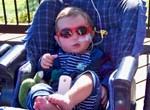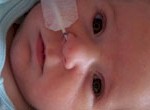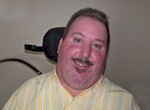Need a New Heart? Grow Your Own.
October 4, 2009
Source: The Boston Globe
Author: Cynthia Graber
The idea sounds like science fiction. But it might someday come true. A group of Boston scientists is pushing the bounds of regenerative medicine.
According to Greek mythology, the god Prometheus granted human beings the gift of fire. As punishment, an angry Zeus condemned Prometheus to a life of torture. An eagle swooped down and tore out his liver every day. But each night, his liver grew back. While this created a nightmare for Prometheus, one element of his story represents the dream of a number of scientists in the Boston area: regrowing cells, tissues, perhaps someday even entire organs or limbs.
Starfish and salamanders are familiar, nonmythological examples of regeneration. Cut an arm off a starfish, and an exact duplicate emerges. The salamander, upon losing a tail, sprouts another. The conventional thinking has been that we, along with all other mammals, lost the ability to regrow entire organs and limbs. Yet there are exceptions. Deer show off new antlers every year. Even children retain vestiges of regenerative capacity: Up to an age of between 7 and 11, if a child loses the top third of a finger, that tip will reemerge.
How can we, like Prometheus and like starfish and salamanders, harness the power of regeneration? If every cell in our body contains an exact copy of the DNA we were born with, the DNA that bears the code for the creation of our body in the first place, is there a way to reactivate that genetic ability? Scientists at the region’s top universities and hospitals — who collectively have created what many in the field regard as this country’s center of regenerative medicine — are determined to answer those questions.
Understanding the promise of regenerative medicine begins with the process of conception. Sperm and egg meet, combine genetic material, and form a single cell that divides again and again. The external layer of cells gets ready to latch onto the uterus wall. Only a small handful of cells, perhaps even a single cell, at the center of the mass, or embryo, prepares to grow into a human being. That cell has the potential to branch off and differentiate into every cell, every tissue and organ in our body. Scientists call that ability pluripotency.
"The cells start making different lineage decisions to become this cell but not that cell," says M. William Lensch, a stem cell scientist at Children’s Hospital Boston. "The complexity is mind-boggling." Some eventually become adult stem cells, which maintain the potential to turn into an assortment of specialized cells: Various stem cells in the bone marrow, for instance, can produce blood, bone, and cartilage.
In 1981, scientists placed mouse embryos onto a petri dish and managed to generate mouse embryonic stem cells. Seventeen years later, human embryonic stem cells were isolated and grown in a laboratory — and their use has provoked controversy ever since. These cells are generally taken from embryos created during in vitro fertilization but never implanted in a patient; IVF clinics around the country have hundreds of thousands of these leftover frozen embryos. Critics argue that life begins at conception and these human embryos should not be used for research. Proponents disagree that life begins at conception and explain that these frozen masses of cells are otherwise destined for destruction. In 2001, President Bush banned scientists from using federal funds to study stem cells from sources other than those that had already been grown. In what researchers see as a boon for the field, President Obama relaxed that ban in March.
Research into cellular differentiation is the basis for regenerative medicine. In a uterus, cells are responding to complex influences including nutrients and chemicals called growth factors, and scientists in Boston have been teasing out the recipes for coaxing cells down a particular pathway.
Three years ago, Japanese researcher Dr. Shinya Yamanaka electrified the field with a startling announcement: He had taken normal skin cells from mice, used viruses to insert four genes, and forced those cells to behave like embryonic stem cells. Such transformed cells are now known as induced pluripotent stem (iPS) cells, referring to the fact that scientists caused skin cells to revert to an earlier, pluripotent state. "There was a lot of skepticism," says Dr. Rudolf Jaenisch, a founding member of the Whitehead Institute for Biomedical Research. "The first cells he made in 2006 were not really embryonic stem cells. They were pretty abnormal. But that showed the principle and shattered the view that differentiation was a one-way path."
Yamanaka’s discovery prompted a flurry of activity among Boston stem cell researchers. Jaenisch’s lab at the Whitehead Institute, along with Konrad Hochedlinger at the Harvard Stem Cell Institute and Yamanaka himself in Japan, replicated and refined the results a year later. Dr. George Daley, director of the stem cell transplantation program at Children’s Hospital Boston, was one of the first to apply the technique to human skin cells in the lab. "I think the great power of that discovery is going to be the next frontier in regenerative medicine," says Jonathan Garlick, director of the division of cancer biology and tissue engineering at Tufts University School of Dental Medicine.
With this discovery, scientists realized they could reverse a seemingly one-way developmental process. In theory, someday an ordinary cell could be taken from a patient, then turned back into an all-powerful pluripotent cell. That cell could be used to create tissue that would match the patient’s genetic profile. In a hint of what the future may hold, in 2008, Harvard Stem Cell Institute researcher Kevin Eggan created the first patient-specific neurons, derived from iPS cells from two women with the neurodegenerative disease ALS.
There are, however, limitations to iPS cells. Because remnants of the viruses used to insert the genes could lead to mutations or cancer, researchers are investigating improved methods for delivering the genes. They’re continuing to study how iPS cells differ from embryonic stem cells. But the creation of iPS cells raised an additional question: Could scientists alter a specialized cell and make it perform a different but related function?
Just last year, this question was answered, when Harvard Stem Cell Institute co-director Douglas Melton published another landmark finding. Melton started with pancreatic cells that do not produce insulin. He introduced new genes and transformed a cell into an insulin-producing pancreatic cell, the kind destroyed in diabetes.
These days, Robert Langer is attempting to help mend spinal cords. A video shows two mice with spinal-cord injuries. One drags his legs behind him, paws splayed. The second has been treated with a piece of engineered spinal cord that has been seeded with nervous-system stem cells. The treated mouse can walk, if a bit clumsily, and his paws appear normal. "It isn’t perfect, but it’s a huge improvement," Langer says. The MIT researcher is now working with spinal surgeons to test this therapy on primates.
Langer, approachable and talkative, oversees one of Boston’s largest and busiest labs. He has his name on more than 750 patents and has won more than 170 awards. Langer is considered the father of the field of tissue engineering, and in the past few decades, he and the hundreds of scientists who have worked with him have revolutionized the creation of artificial structures on which cells live and thrive, much as they do on natural tissue. This allows the work of regenerative medicine to leap from a petri dish to a more realistic three-dimensional world.
Building on Langer’s principles of tissue engineering, Garlick, the Tufts researcher, in July presented the first skinlike tissue crafted from human embryonic stem cells. To create the skinlike tissue, Garlick and his lab nurtured two different types of cells derived from embryonic stem cells and brought them together on a substance that approximates skin building blocks. Tiny dimes of a pale opaque pink, the color of a wound beginning to heal, float atop their nutrient bath. "Sometimes I swear I can see little fingerprints on top," says Garlick, visibly thrilled.
But providing a three-dimensional structure itself isn’t always enough. Cells are subject to external forces such as tension and pressure. In a fetus, it is the very force of the beating of an early heart that causes blood cells to form, as both George Daley’s and Dr. Leonard Zon’s labs at Children’s Hospital demonstrated.
In his laboratory off Harvard’s main yard, Kevin Kit Parker of the Harvard Stem Cell Institute borrows from computer microchip technology to create patterns on a film that force cells to grow in a specific shape and in a certain direction. This not only affects how the cells look but also how they behave.
Parker has teamed with Dr. Kenneth Chien, director of Massachusetts General Hospital’s Cardiovascular Research Center, to use Parker’s technology to force heart stem cells, grown from embryonic stem cells, to take on the shape of cardiac muscle cells. "They actually start thinking they’re cardiac muscle cells," says Parker. Within confines, the cells link up to one another, as do normal cardiac muscle cells. The results of their collaboration could lead to the first example of a fully functional strip of heart muscle tissue created from embryonic stem cells.
Regenerative medicine can be viewed as the meeting of cellular biology and tissue engineering; combining those two fields allows researchers to grow rudimentary examples of living tissue. Still, challenges remain, such as how to encourage the growth of blood vessels that will then connect an engineered tissue to the patient. And scientists need to be able to regulate the dividing capability of introduced stem cells so they do not turn cancerous. But even were these problems solved, the complexity of an entire organ would still need to be mimicked. The heart, for instance, contains a variety of cells in a delicate dance within a structure that includes chambers, vessels, and pumps. How do our cells know to design such complex growth?
This question is one that has kept Michael Levin awake at night. "How does a single cell reliably self-assemble into a snake or ostrich or fish? It’s a remarkable process," says Levin, a Tufts University professor and director of the Tufts Center for Regenerative and Developmental Biology. He believes one answer might lie in electricity.
Each and every cell has an electric flow across its membrane, says Levin, "and, in fact, cells spend a lot of energy maintaining various electrical signals that they’re sending out to themselves and other cells around them." Levin says researchers have known for some time that the site of a wound produces an electrical field. But only recently have research instruments allowed this flow to be investigated at the molecular level.
Levin says electrical signals tell cells what to repair and how to re-create what was lost. Levin deciphered one of those cues, a protein in a tadpole that creates a flow of protons, which produces an electric field at the site of a lost tail, starting a voltage flow. "If you block that flow, the tail won’t grow back." Levin took a tadpole that matured past the ability to regenerate a lost tail. He removed the tail, then manipulated proteins to turn on the switch. This "triggers tail regeneration and stops the tail growth when it’s complete. The tadpoles end up with perfectly sized tails like their siblings."
Levin is now working with tissue engineer David Kaplan to develop what he calls a bioreactor, which could encourage the same regeneration in mammals, starting with rats. "Down the line, we hope to translate this into biomedical applications that can help people," says Levin.
Scientists say the more they learn, the more they realize what lies beyond their grasp. "These are exciting times in stem cell biology, and there have been exponential advances," notes Chien, the MGH researcher. "And at the same time, the gap between stem cell biology and true regenerative medicine has never been wider."
Some diseases, however, might be cured with changes to a single cell. Jaenisch’s lab at the Whitehead Institute created iPS cells from a mouse with sickle cell anemia, a blood disorder. They corrected the gene that causes the disease, then coaxed those cells into adult blood stem cells. Upon injection, stem cells found their way to the animal’s bone marrow and cured the disease. Demonstrating the promise of adult stem cells, a Colombian woman received an entirely new windpipe last year. The donor pipe came from a cadaver, was stripped clean of its original cells, and then was repopulated with the patient’s adult stem cells, which grew into the appropriate tissues.
But when it comes to cultivating entire organs from scratch, research is still in its infancy. What energizes scientists today, however, is the promise that iPS cells hold for a deeper understanding of diseases. George Murphy, a researcher at the Boston University Center for Regenerative Medicine, likens iPS cells to a flight recorder that contains information on a crash. "You can see all the events that led up to this disastrous event," he says. "You can take a cell from a patient with a genetic disease and replay the onset of that disease again and again."
Another source of enthusiasm is the potential for drug discovery. Lab animals do not always show how a chemical will affect humans, but lab-created human tissue may soon offer a rapid and efficient model for drug testing.
Scientists caution that the ultimate promise of readily available, personally matched tissue may remain decades away. Still, the pace of discovery has raced ahead, surprising even those involved in the search. "This is the ultimate in terms of creative science, to think about cells capable of becoming anything," says Dr. David Scadden, co-director of the Harvard Stem Cell Institute. "The field is wide open for innovation."



